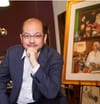- Redefining identity: How Re(Defining) Singapore captures the changing cultural and social fabric of a maturing nation.
- The art of storytelling: From Soul of Ink to television news, Woon explores truth and creativity as parallel forces shaping Singapore’s narrative.
- Journey as writer: Woon’s books often blend biography, reflection, and national identity to reflect his view of the subject and his thinking.
By Sebastian Lim
MEDIA visionary, author, and cultural advocate Woon Tai Ho has spent his life telling Asia’s stories — through news, art, and the written word. As the founding CEO who helped launch Channel NewsAsia, Woon shaped a platform that connected the region to itself and the world. His literary works, from Art of Joy to Soul of Ink: Lim Tze Peng at 100, reveal his deep sensitivity to the creative spirit and the evolving Singapore identity.
On Nov 17, 2025, Woon’s latest book, Re(Defining) Singapore, will be launched by President Tharman Shanmugaratnam at the National Gallery, marking another milestone in his lifelong exploration of what it means to be a Singaporean.

In Part 1 of the conversation, Woon reflects on the intersections between art, media, and nationhood — and how storytelling continues to define both his craft and country.
On New Book: (Re)Defining Singapore
What inspired you to “write” (Re)Defining Singapore, and how does it differ from your previous works such as Soul of Ink or Art of Joy?
This book was initiated by two women, Bianca Cheo and Fiona Leung. They are businesswomen, and whenever they travel, they are always asked, “How did Singapore make it from third world to first in such a short time?” A nation so small, yet it has achieved so much. Does Singapore have a “secret sauce” for governance?
I was asked by them to be the editor / interviewer / co-writer of this book project. My role is to source names who have contributed to make Singapore what it is today, interview them and use their answers to put together essays on their behalf.

We managed to get contributions from some of the biggest names in Singapore, from Tommy Koh to Kishore Mahbubani, Philip Yeo to Violet Oon, Joseph Schooling to Yip Yew Chong. We also have opposition voices, like Michael Tung from the Worker’s Party.
So I am not exactly the author of the book, but an editor, and this therefore is very different from all the other books I have written. This book is unusual also because at the end of every essay is a QR code. Readers can scan and get to see video highlights of the interviews I have done for each contributor. It marries two of what I do in my life, interviewing people on video and writing.
The title itself suggests a re-examination of national identity. In what ways do you feel Singapore is being “redefined” today?
Early Singapore impressed the world as an economic miracle. It also had a civil service that was one of the most efficient and cleanest in the world. It consistently ranked No.1 in almost every category that mattered – education, housing and communications.
Today, Singaporeans, especially those who did not experience separation and the early years of nation building, take these for granted. Many developing countries have caught up, and for Singapore to stay ahead, its leaders need to have a mindset different from the pioneers. Our HDB blocks are aging, how do you house a nation whose population aspires to live in private condo and landed property? MRT at peak hours are crowded and uncomfortable, is there a viable alternative? Many, many new questions.
Many Singaporeans are no longer relying on the government to “take care of them”. Charles and Keith, for example, grew from a one-stall shoemaking operation in Ang Mo Kio to nearly 700 retail stores across more than 30 countries, all on their own without government help. Joseph Schooling won the republic's first gold medal at the Olympics very much on the resources of his parents, not the government.
So while the government continues to provide excellent infrastructure and basic institutional support, individuals prefer to strike out on their own, either in Singapore or abroad. Most importantly, Singaporeans no longer consider having a single party politically healthy. So the Worker’s Party is now a strong alternative party for many Singaporeans. One of the young Worker’s Party members is a contributor to this book.
You’ve written extensively about artists and cultural figures. How does art, in your view, help to shape or redefine the Singapore story?
Art reflects the soul of a nation. Through painting, sculpture, film and performance, artists capture the emotional truths that statistics and policy cannot. From kampung scenes of pioneer artists to today’s explorations of identity, displacement, and belonging, art records how Singaporeans FEEL about progress, not just what we achieve. It holds and preserves memory amid rapid change. Through art, the Singapore story becomes not just about economic success, but a shared imagination and humanity.
In the course of researching for this book, what new understanding of Singapore surprised you most?
What surprised me most was a contribution by a formal drug offender. I will quote from him: “In Singapore, we have made enormous strides in the past 60 years. From the third world to first, we have built one of the most efficient, safe and advanced societies in the world. Our public housing is a global model. Our education system is a point of national pride. Our social service sector is built on decades of tireless work from community groups, religious organisations, halfway houses and rehabilitation service. But despite these, recidivism – especially for drug-related offenses – remains stubbornly high. We must ask why…
"I often wonder what would have happened if someone had pulled me aside at 14, not with a lecture or scolding, but to have a genuine conversation.”

On journey as a writer
Soul of Ink won the Dr Alan HJ Chan Spirit of Singapore Book Prize for capturing Lim Tze Peng’s spirit. What did that recognition mean to you personally and professionally?
It was genuinely a big surprise and a big moment. There are many writers, but to be an award-winning one allows one to be noticed professionally. Personally, it is a nod to my ability with words, and my ability to bring out the story of resilience, courage and determination of a 100-year-old man who believed in his art. Lim Tze Peng was among the audience when I went up on stage to receive the award. I saw sheer joy on his face. That joy will forever stay with me. Soul of Ink was World Scientific’s first book on art. They took a gamble, and it paid off. So, there will probably be more.
Your books often blend biography, reflection, and national identity. What draws you to this intersection between art, personal narrative, and society?
I took art as a subject up till Pre University Two. I then went on to do honours in Political Science, History and Philosophy. But art never left me. After university, I wrote on art for both The Straits Times and Business Times and several regional magazines.
When I joined MediaCorp as a director / producer, I did a documentary on multi-disciplinary artist Tan Swie Hian. When he read the script, he advised me to convert the script into a book. I took a year to do that, and that was the start of my writing career. Because of my background in Political Science, History and Philosophy, my biographies would always have that bigger picture context, of how identity and society fit in.
How do you balance the journalistic instinct for facts with the writer’s search for emotion and meaning?
I don’t think the word is balanced. It comes naturally and instinctively. Many critics have said I write pictorially, I describe a scene almost like I am using paints, not words. Emotions are also facts, and facts can be emotionally conveyed. Meaning is just that, meaning.
Click here for Part 2 of the conversation with Woon Tai Ho on Exploring storytelling in new media.





